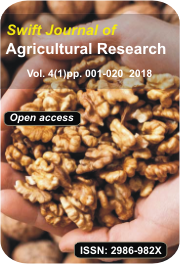Journal Categories

Swift Journal of Agricultural Research (SJAR)
October 2018 Vol. 4(1), pp. 001-020
Copyright © 2018 Swift Journals
Original Research Paper
De Novo Transcriptome Assembly and Comparison of Walnut (Juglans regia L.) cv. Qingxiang Organs: Roots, Stems and Leaves
*Benzhong Fu1,2 Lulu Zou1
1College of Life Science and Technology, Hubei Engineering Universit.
2Hubei Key Laboratory of Quality Control of Characteristic Fruits and Vegetables, 272# Jiaotong Avenue, Xiaogan city,Hubei province, 432000, China.
*Corresponding Author E-mail: benzhongf@yahoo.com
Accepted 8th September, 2018
Abstract
Due to its medicinal benefits to human health, such as improving the cardiovascular system, reduce problems in metabolic syndrome and anti-cancer, Persian walnut (Juglans regia L.) has become one of most important stone fruits all around the world. China is presently the largest walnuts producer in the global. However, there are still few genomic and transcriptomic data of commercial walnut cultivars, especially about their adult organs and tissues, including the roots, stems and leaves. Also, there are no data that is available about walnut cultivar Qingxiang, which is one of the major cultivars that are being planted in China. In this study, Illumina RNA sequencing (RNA-Seq) was performed on samples collected from J. regia cultivar Qingxiang roots, stems and leaves. The data obtained were used for de novo assembly and the characterization of the transcriptome of three organs. In total, 85,232,619 paired-end reads were generated with 17,215,394,747 nucleotides and GC percentage was 46.18%. These were assembled into 4,336,022 contigs with 94,500 transcripts and 51,807 unigenes. The unigenes were annotated by querying against the NCBI non-redundant and UniProt databases, 28,209 unigenes (54.45%) were homologous to the existing database sequences. Gene Ontology terms were doled out to 23,451 unigenes, 8,292 loci were coordinated to 25 Clusters of Eukaryotic Orthologous Groups arrangements, and 5,885 unigenes were characterized into 116 Kyoto Encyclopedia of Genes and Genomes pathways. The gathered unigenes(more than 1 kb)also contained 6,244 potential straightforward grouping repeats. The put together transcriptome was utilized to distinguish unigenes with organ-particular differential articulation designs. In total, 942 unigenes exhibited organ-specific expression. Our data analyses implied that walnut different organs expressed specific genes in many molecular processes and functions, particular, the plant-pathogen interaction pathways were demonstrated. The existing genomic transcriptomic data from China major walnut cultivars are scarce. The walnut organ-based transcriptome resources developed in this study will enable the analysis of organ development, and accelerate marker-assisted breeding based on SSRs and understanding the disease resistance in walnut. Furthermore, this study provides an enhanced insight into the organ response of probably pathogen infection.
Keywords: Walnut; organ; transcriptome; Illumina; RNA-seq; unigene.
Read [Full Text - PDF]
